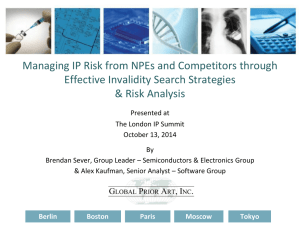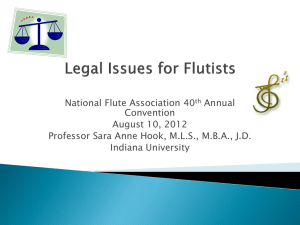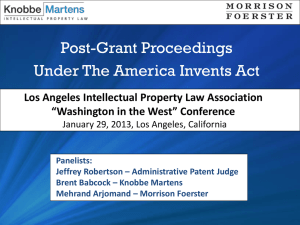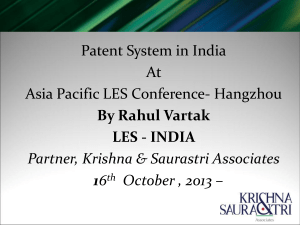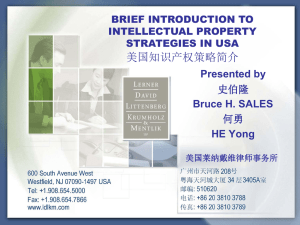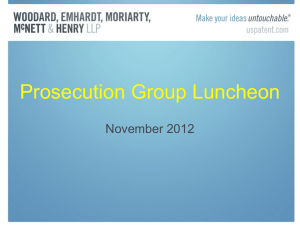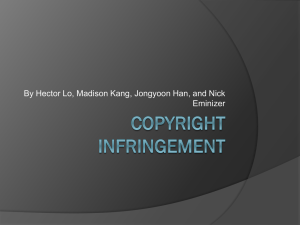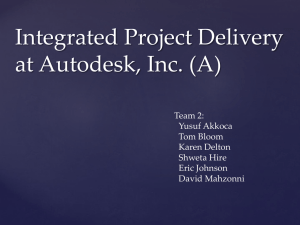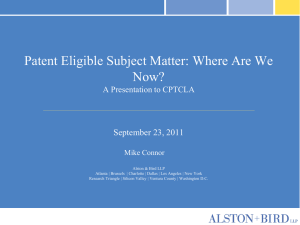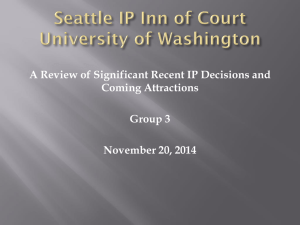2011 Patent Reform`s Impact on Litigation
advertisement
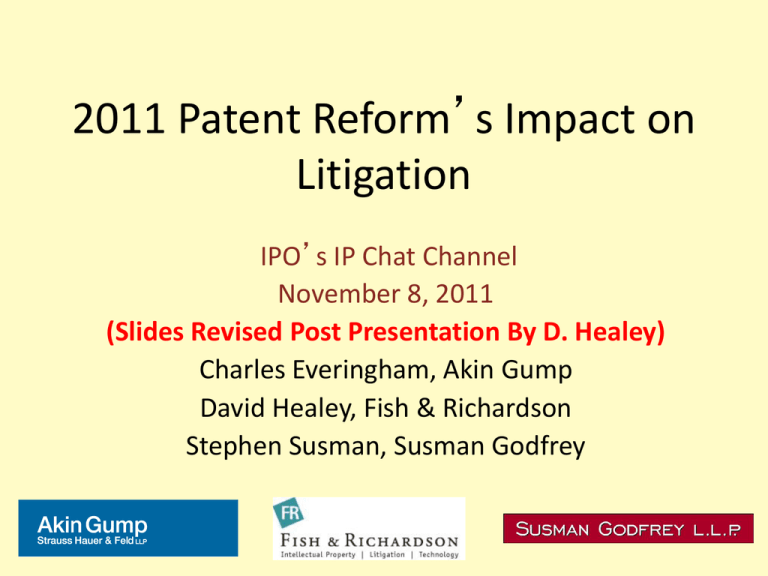
2011 Patent Reform’s Impact on Litigation IPO’s IP Chat Channel November 8, 2011 (Slides Revised Post Presentation By D. Healey) Charles Everingham, Akin Gump David Healey, Fish & Richardson Stephen Susman, Susman Godfrey First A Word from the “GC” • These slides are to provoke discussion only. • The slides are not legal advice. • The slides do not represent the positions of any client or firm or attorney. • The applicable law on any set of facts will be different from the general overview in the slides. For Discussion Only 2 Changes in 2011 Leahy-Smith Act • Little Substance Addressed: – Vaporized False Marking Cases as private Qui Tam Actions without any requirement for injury to plaintiff. – Created “Virtual Marking”: Web-based “notice of patent”. – Elimination of “Best Mode” as basis to later invalidate patent (but not as requirement for patent to issue). For Discussion Only 3 Changes in 2011 Leahy-Smith Act • Little Substance Impacting Litigation: – Did not address substantive changes in prior bills due to judicial revision of patent law: • Damages: Lucent v. Gateway, 580 F.3d 1301 (Fed. Cir. 2009); Uniloc v. Microsoft, 632 F.3d 1292 (Fed. Cir. 2011). • Injunction: eBay v. MercExchange, LLC, 547 US 388 (2006). See also Robert Bosch LLC v. Pylon Mfg. Corp., 2011 WL 4834266 (Fed. Cir. 2011). • Venue: In re TS Tech USA Corp., 551 F.3d 1315 (Fed. Cir. 2008). For Discussion Only 4 Section 299: Procedural Changes The Leahy-Smith America Invents Act of 2011 has important procedural changes for patent litigation: – 28 U.S.C. Section 1295(a)(1): Expansion of Federal Circuit Jurisdiction; – 35 U.S.C. Section 299: Joinder of defendants in a single lawsuit. For Discussion Only 5 AIA: Other Changes – Other Sections of Title 35 Amended by Act could impact litigation as they are implemented over time: – 321-329: Post-Grant Review process; – 311-319: Inter Partes Review process; – 287(a): Virtual Marking; – 112: Elimination of Best Mode Defense. For Discussion Only 6 Section 299 • Prohibits joinder of defendants in a single lawsuit or in a single trial: – Unless same transaction or occurrence or series of transactions or occurrences; – Must allege joint, several or alternative liability; – Must be same product or process; – Statute expressly states a claim of infringement of the same patent is not enough to meet this test. For Discussion Only 7 299: Mandate for FRCP 20 • House Report expressly criticizes expansive view of FRCP 20: – [Footnote 61: Section 299 legislatively abrogates the construction of Rule 20(a) adopted in MyMail, Ltd. v. America Online, Inc.,223 F.R.D. 455 (E.D. Tex. 2004); Sprint Communications Co. v. Theglobe.com, Inc., 233 F.R.D. 615 (D. Kan. 2006); Adrain v. Genetec Inc., 2009 WL3063414 (E.D. Tex. September 22, 2009); Better Educ. Inc. v. Einstruction Corp., 2010 WL 918307 (E.D. Tex. March 10, 2010); Mannatech, Inc. v. Country Life, LLC, 2010 WL 2944574 (N.D. Tex. July 26, 2010); Alford Safety Services, Inc., v. Hot-Hed, Inc., 2010 WL 3418233 (E.D. La. August 24, 2010); and Eolas Technologies, Inc. v. Adobe Systems, Inc., 2010 WL 3835762 (E.D. Tex. September 28, 2010)--effectively conforming these courts' jurisprudence to that followed by a majority of jurisdictions. See generally Rudd v. Lux Products Corp., 2011 WL 148052 (N.D. Ill. January 12, 2011).](emphasis added). For Discussion Only 8 Section 299 • What you can do? NO ONE KNOWS YET! • Sue based on? – Industry standard: Against those who participated in standard-setting (inducement) and implement standard (direct infringement)? – Indirect infringer and direct infringer? – Joint infringers? – One retailer for sales of multiple brands of same product? – MDL or coordination within district and division? – DJ counterclaims are arguably outside of statute? – International Trade Commission? For Discussion Only 9 Section 299: Standards • Patent owners/applicants involved in setting standards are required to give SSO and other members/participants notice of patents/applications they allege will be infringed and their licensing policy. • Infringement can in some cases be proven by showing industry standard infringes. • Is industry standard a) common nucleus of fact for transaction or occurrence test, and b) same product or process, for joinder of direct infringement claims? • Arguably inducement claims based on participation in creation of standard and also use of standard can be joined? For Discussion Only 10 Section 299: Standards Are products or process that practice the standard the same? • Handsets that must meet CDMA or WCDMA standards? • Semiconductor memories that must meet JEDEC pin out, packaging (size, thickness), clock, other interoperability standards? • Flash memory cards that must meet interface standards? • Computers that must meet USB standards, wireless standards, or ethernet standards? • Standards for chemical or refinery plant components, conduit for wiring, safety devices on hot water heaters, “best practices” for methods of operations, etc.? • Are standards implemented to induce compliance by new market entrants? For Discussion Only 11 299: Indirect Infringement: Inducement and Contributory Notice of patent and potential infringement through virtual marking and website publicity, coupled with “willful blindness”? PARTY A PARTY A Instructs on Use Makes and Sells Software (Inducement to perform method or to combine with computer) (apparatus/specially made) For Discussion Only Party B operates software (method) or combines it with hardware (apparatus) 12 299: Indirect Infringement-Same series of transactions or occurrences? All XY Memory Cards must fit all XY products Virtual marking creates notice of patent Making XY product arguably induces more card mfg All XY products must accept all XY Cards Making XY Card arguably induces product mfg For Discussion Only 13 299: Joint Infringement? Joint infringement is direct infringement: No intent required. Wireless Service Provider 2 Wireless Service Provider 1 Contracts to connect calls, texts, data/email, crossbilling arrangements, roaming ISP For Discussion Only 14 1 Retailer: X Brands of TVs Sold. Advertising infringes “offer to sell”. Operation of TVs on display infringes method claims. Sales infringe apparatus claims 299: Retailer suit – Eliminates joinder issue Method claim=same process. TV=same product. Advertising and sales=same series of transactions or occurrences. Display and sale within the district = venue Can retailer displays, advertising, product placement, create basis to sue manufacturers in one case? Damages on retailer’s margins For Discussion Only 15 299: MDL? • 299 only prohibits single suit and single trial. • 299 does not prohibit Pretrial Coordination or Multi-District Litigation. • Pretrial coordination or MDL can cover discovery, claim construction and summary judgment. For Discussion Only 16 Parts (b) and (c) of 299 • (b) Allegations insufficient for Joinder – For purposes of this subsection, accused infringers may not be joined in one action as defendants or counterclaim defendants or have their actions consolidated for trial, based solely on allegations that they each have infringed the patent or patents in suit. • (c) Waiver - A party that is an accused infringer may waive the limitations set forth in this section with respect to that party. For Discussion Only 17 Section 299(b) & (c): DJ Claims? • DJ is a separate claim: Is it a “waiver”? – Not required: Often brought to force patentee to “Super Sack” claims that patentee drops. • Super Sack Mfg. Corp. v. Chase Packaging Corp., 57 F.3d 1054, 1057 (Fed. Cir. 1995). • No explicit prohibition against consolidated trial on DJ claims of invalidity or other counterclaims. • One invalidity trial reduces patentee’s cost and risk and reduces judicial burden. • Clearly common fact questions under 299(a)(2); but is it the same series of transactions or occurrences under 299(a)(1)? For Discussion Only 18 299: Does It Apply To ITC? • 299(a) applies “to any civil action arising under any Act of Congress relating to patents…” • ITC action is distinguished in AIA from a “civil action” in 28 U.S.C. 1295. Compare parts (a)(1) and (a)(6). • ITC remedy is order excluding importation: Often “better than damages”. • ITC case law requires joinder of impacted parties. For Discussion Only 19 Post-Grant Review and Litigation • Post grant review even when fully implemented still may not be “cure all”: • 2 Types of Post Grant review will be implemented over time: – Post grant review within 9 months of issue (Sections 321329): • Can be based on any ground and bars any later invalidity issue in litigation that could have been raised in review; • Written ruling of the Patent Trial and Appeal Board (PTAB) of PTO is the bar. – Inter Partes Review after 9 months from issue (Sections 311-319): • On publications and patents only; • Standard raised to likelihood of success; • PTAB’s written decision is the “bar”. For Discussion Only 20 Post-Grant Review and Litigation For both could turn out to be 37-49 month time line: • • • • Suit filed; “Guesstimate” 3 or more months for defendant to file; Director to set response time (3 months?); 3 months to initiate AFTER response or time for patentee to file initial response lapses; • 1 year to 18 months to PTAB decision; • Approximately, 19-25 Months from filing of suit to PTAB decision - collateral estoppel? • 18 months to 2 years to appeal to Federal Circuit? For Discussion Only 21 Pluses Minuses Post-Grant review will eventually allow full litigation of invalidity in PTO to Judge. Inter Partes Review remains limited to publications and patents. Post-Grant Review will deprives defendant of any invalidity defense at trial for claims that survive or emerge. Inter Partes leaves other “jury friendly” art for trial (e.g., devices). Post-Grant will be limited to 9 months of issuance of patent. Time to resolution probably 19-25 months from filing suit depending on when defendant files for review: Is this more incentive for district court to stay lawsuit? Higher standard to initiate-less likelihood of acceptance-lower incentive to stay pending initiation by PTO. Collateral estoppel bar sets in at PTAB written decision not Federal Circuit appeal. Post Grant Review Pluses/Minuses Higher standard to initiate will show more Can result in amended claims tailored to potential upside from stay. accused product: “Go from bad to worse”. Can wipe out patent. Re-examined patent is almost impossible to Can create intervening rights to revised or new attack in later lawsuit or trial. claim. Can create willfulness defense if accepted by For Discussion Only 22 PTO based on “likelihood” standard. Elimination of Best Mode Defense • Best Mode is only part of 112 written description requirement: – Subjective to inventors; never a strong defense. • Preferred embodiment will always be in patent. • Enablement still requires complete written description, figures, at least one preferred embodiment. • PTO still will require disclosure of Best Mode for patent to issue. For Discussion Only 23 Elimination of Best Mode Defense • Elimination of Best Mode is not a “big deal” to Patent Litigation. • But is a potential trap for patent drafters: – May reduce care taken in drafting applications since reduces consequences of sloppy work? – May cause drafters to fall short on enablement? – May cause drafters not to describe or claim features of actual commercial products they are trying to protect? For Discussion Only 24 28 U.S.C. Section 1295(a)(1): Federal Circuit Jurisdiction • Expansion of Federal Circuit Jurisdiction: – Overrules 2002 US SCT decision in Holmes Group, Inc. v. Vornado Aircirculation Systems, Inc., 535 U.S. 826 (2002); – Gives Federal Circuit jurisdiction of “any civil action” where a patent issue is raised in a claim or counterclaim. For Discussion Only 25 28 U.S.C. Section 1295(a)(1) Federal Circuit favors patents over competition: • In re Princo Corp., 478 F.3d 1345 (Fed.Cir. 2007) (circumscribing patent misuse under 271(d)); • Rambus v Infineon Techs AG, 318 F.3d 1081 (Fed. Cir. 2003)(disfavors counterclaims on standard-setting conduct); • In re Independent Service Organizations Antitrust Litigation, 203 F.3d 1322 (Fed. Cir. 2000)(CSU, Xerox)(giving immunity to unilateral acts by patentee); • Intergraph v. Intel, 195 F.3d 1346 (Fed. Cir. 1999)(limiting antitrust claims to those enumerated in the past by US SCT). What you can do: File in state court without challenging validity or scope of patent. For Discussion Only 26 “Substance Trumps” Patent Litigation is driven more by remedies, less so by procedure. Remedies are a function of substantive law. Procedure should not impact substantive law. Have Courts more than Congress impacted the value of patents by limiting remedies? Increased litigation cost and time will have negative impact, but not drive value as much as remedy… For Discussion Only 27


